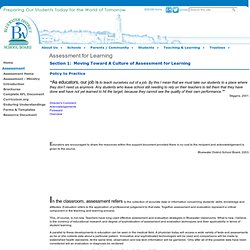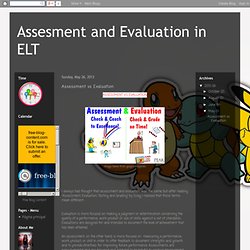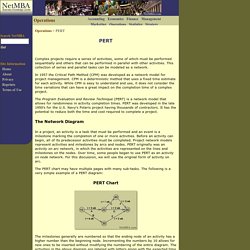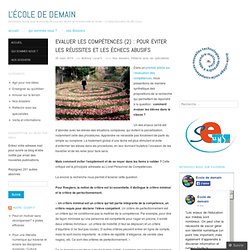

Section 1: Moving Toward A Culture of Assessment for Learning. Section 1: Moving Toward A Culture of Assessment for Learning Policy to Practice ""As educators, our job is to teach ourselves out of a job.

By this I mean that we must take our students to a place where they don’t need us anymore. Any students who leave school still needing to rely on their teachers to tell them that they have done well have not yet learned to hit the target, because they cannot see the quality of their own performance. "" Stiggins, 2001. Educators are encouraged to share the resources within this support document provided there is no cost to the recipient and acknowledgement is given to the source. Bluewater District School Board, 2003. In the classroom, assessment refers to the collection of accurate data or information concerning students’ skills, knowledge and attitudes. This, of course, is not new. A parallel to these developments in education can be seen in the medical field. In our classrooms, teachers are like those medical professionals. David Armstrong. Learning Module: Assessment.
Learning Module: Assessment. Assessment vs Evaluation. I always had thought that assessment and evaluation was the same, but after reading "Assessment, Evaluation, Testing and Grading" by Craig I realized that those terms mean different: Evaluation is more focused on making a judgment or determination concerning the quality of a performance, work product or use of skills against a set of standards.

Evaluations are designed for and intended to document the level of achievement that has been attained. An assessment, on the other hand, is more focused on measuring a performance, work product, or skill in order to offer feedback to document strengths and growth and to provide directives for improving future performance. Assessments are nonjudgmental and are designed and intended to be helpful to produce improvement. Section 1: Moving Toward A Culture of Assessment for Learning.
Www.tillvaxtanalys.se/download/18.56ef093c139bf3ef8902554/1349863306668/evaluation-definitions-methods-and-models-06.pdf. Alternatives to Kirkpatrick: Kaufman’s 5 Levels of Evaluation. Meaningful instructional design requires meaningful evaluation.

However, evaluation, like organizational development itself, requires buy-in at many levels. This buy-in’s necessary… To identify meaningful metrics To collect dataTo react to data, making appropriate improvementsTo undertake change management necessary for these improvements If you’ve been in this field for any length of time, you’ve probably come across Kirkpatrick’s four levels of evaluation (reaction, learning, performance, & results).
Kirkpatrick’s approach has come under fire for a number of reasons (e.g., emphasis on training events, implied linearity and causality, and more) and many articles have provided thoughtful critiques. However, in this series of posts, I haven’t come to bury Kirkpatrick’s approach or to praise it. One alternative: Kirkpatrick Plus Articulated by Kaufman, Keller, and Watkins (“Kaufman”) (1995), this evaluation framework connects performance to expectations. A better model? Reference. Www.embrion.co.uk/Images/378/SOAP_M-HR-evaluation2012.pdf. SOAP_M-HR-evaluation2012.pdf. PERT Chart. Operations > PERT Complex projects require a series of activities, some of which must be performed sequentially and others that can be performed in parallel with other activities.

This collection of series and parallel tasks can be modeled as a network. In 1957 the Critical Path Method (CPM) was developed as a network model for project management. CPM is a deterministic method that uses a fixed time estimate for each activity. While CPM is easy to understand and use, it does not consider the time variations that can have a great impact on the completion time of a complex project. The Program Evaluation and Review Technique (PERT) is a network model that allows for randomness in activity completion times. The Network Diagram In a project, an activity is a task that must be performed and an event is a milestone marking the completion of one or more activities.
075184eo.pdf. PERT.pdf. Western Michigan University Evaluation Center. Wp-content/uploads/2011/07/cippchecklist-Attch-2.pdf. Www.eureval.fr/IMG/File/FT_Entretien.pdf. Evaluer les compétences (2) : pour éviter les réussites et les échecs abusifs. Dans un premier article sur l’évaluation des compétences, nous présentions de manière synthétique des propositions de la recherche qui permettent de répondre à la question : comment évaluer les élèves dans la classe ?

Un des enjeux cerné est d’aborder avec les élèves des situations complexes, qui évitent la parcellisation, notamment celle des procédures. Apprendre ne nécessite pas forcément de partir du simple au complexe. La traitement global d’une tâche est plus stimulant et évite d’enfermer les élèves dans les procédures, en leur donnant toutefois l’occasion de les travailler et de les relier pour faire sens. Mais comment éviter l’empilement et de se noyer dans les items à valider ? Cette critique est la principale adressée au Livret Personnel de Compétences. Là encore la recherche nous permet d’éclairer cette question. Pour Roegiers, la notion de critère est ici essentielle. La règle des 2/3 : pour déclarer un élève compétent, chaque critère minimal doit être respecté. Critères d’évaluation d’une formation. Construire un guide d'entretien. Www.melissa.ens-cachan.fr/IMG/pdf/aide_memoire_entretien.pdf.